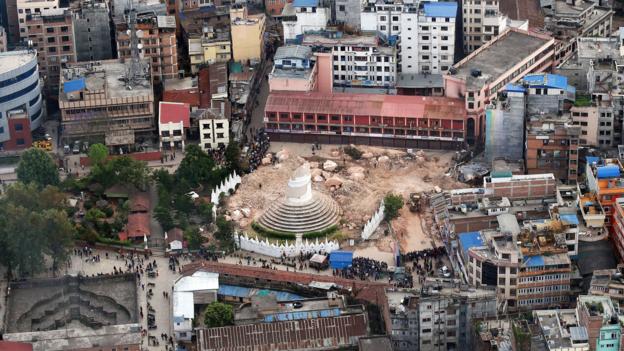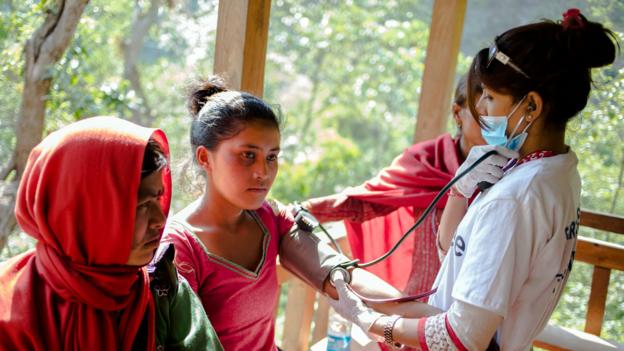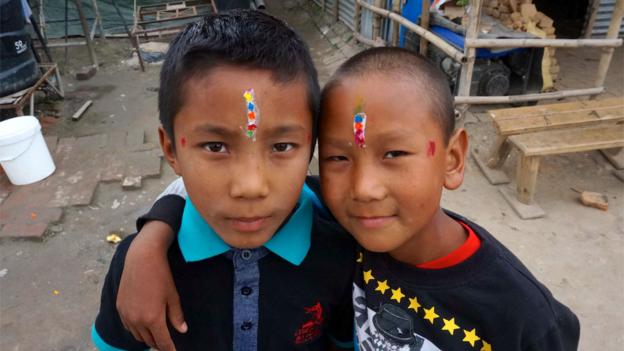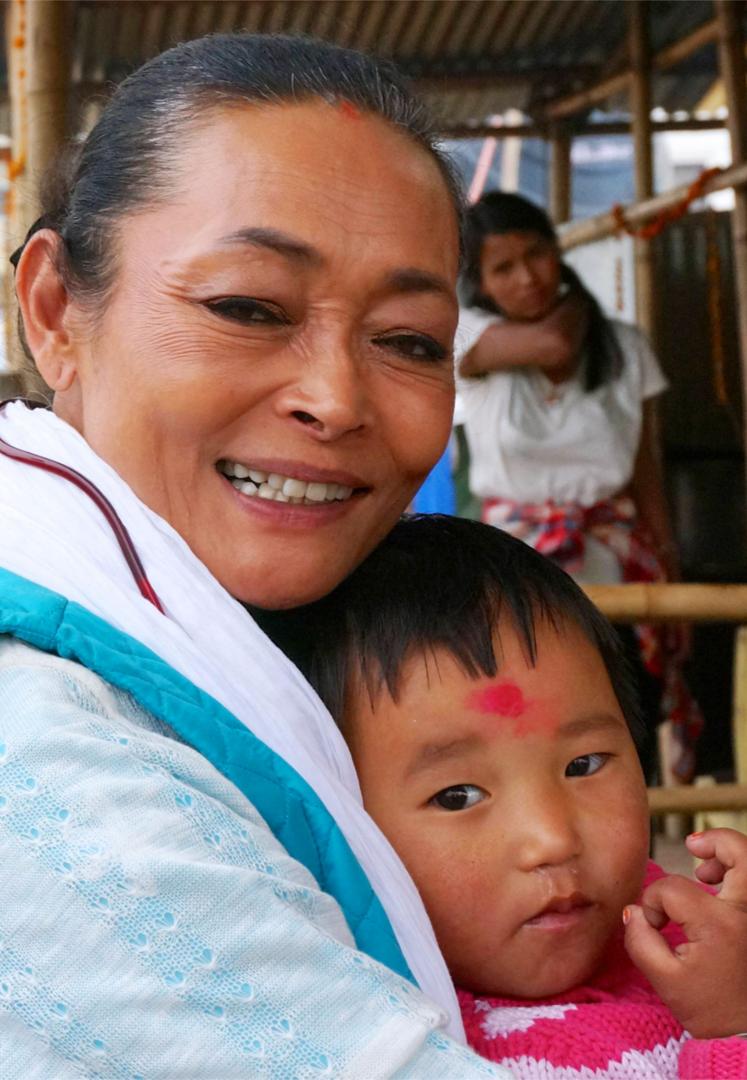When I think about the chance encounters I’ve had in my travels, dominoes come to mind. Every effect has its cause, sometimes stretching back for weeks, years, or (in this case) eons. It’s as if time itself conspires, wilfully, to set up the cascade that tumbles us into the present moment, as if no encounter truly happens by chance.
The domino metaphor is uniquely appropriate in this story. It’s set in Nepal, my second home since 1979, and to where I’d return as a visitor or resident almost every year for the next three decades. But on 25 April 2015, at 11:56 am, two plates of the Earth’s crust shifted slightly. Their movement caused a deadly earthquake that toppled buildings, levelled ancient temples, triggered horrific landslides and sent houses – especially in Nepal’s Sindhupalchowk district – cascading down hillsides. More than 8,800 Nepalis were killed, and hundreds of thousands made homeless.

A collapsed temple in the Unesco World Heritage site of Bhaktapur, Nepal (Credit: Omar Havana/Getty)
Given my long connection to the place, it is not surprising that I felt the tremors in my own core when the massive earthquake struck. Part of me wanted to fly immediately to Kathmandu and do whatever I could. But I knew, having worked in disaster zones before, that without a clear and essential role, I’d just be a nuisance.
So six months later, I travelled to Nepal with a purpose: to visit some of the more successful relief efforts and report on the country’s recovery. I knew I’d see people whose lives had been devastated, but planned to remain objective. And I did a pretty good job at it – until I visited Camp Hope, and met a 10-year-old girl from Sindhupalchowk.
* * *
Pedro and Lorenzo, two young backpackers from Portugal, had never heard of Sindhupalchowk. “Frankly,” said Pedro, “we didn’t know anything about Nepal.” They’d arrived the night of 24 April, deep into an open-ended trip across Asia. Their plan was to wake early, climb to the top of the newly restoredDharahara, a historic 62m-high monument overlooking Kathmandu, and then go trekking.
The next day, predictably, they overslept. Just as they left the hotel, the earthquake struck. The delay had saved their lives: all 180 people in and around the Dharahara were killed by the falling tower.

The remains of Dharahara, a historic 62m-high monument overlooking Kathmandu (Prakash Singh/AFP/Getty)
Though a flight home was offered, Pedro and Lorenzo didn’t leave Nepal. They stayed, using their savings to buy rice, vegetables and fruit for the terrified locals camped on the streets. During the next three weeks, their story – which they posted on Facebook – went viral. Tens of thousands of euros flowed in, bolstering their ragtag relief efforts. During the following weeks, they worked non-stop, bringing food, supplies, and clothing to people made homeless by the disaster. As the tourist district was in shambles, they’d been granted refuge atDwarika’s, an elegant local hotel that also hosts the Spanish Consulate.
Dwarika’s is managed by Sangita Shrestha, whose mother owns the property. The Shresthas had also started some rebuilding projects, and soon the two Portuguese were involved with those as well. Then another domino fell.
“In mid-May,” Pedro recalled, “someone came to Dwarika’s and told us that 350 people – men, women and 81 children – had been evacuated by helicopter from an area called Sindhupalchowk. They’d been left in an empty lot, without clothes, food or water. So we got a few vans,” he said, “and brought them basic supplies.”

Nepalese volunteers distributed aid to survivors in the wake of an earthquake (Credit: Rebecca Conway/AFP/Getty)
Sangita, Pedro, Lorenzo and half a dozen new volunteers banded together to care for these uprooted Nepalis. Sangita secured the use of an empty football field, and within days a tent city was created. Water was trucked in, electric wires connected and a kitchen set up. The children were enrolled in a nearby public school. Pedro gave the settlement a name: Camp Hope.
In October 2015, I arrived in Nepal to write my story. I’d installed myself at Dwarika’s and was scoping out interesting relief projects. One morning, Sangita joined me for coffee. “There is a project,” she said, “that I very much want you to see.”
* * *
When we arrived at Camp Hope, a large group of adults and scores of children awaited us, pressing their hands together in the traditional Nepali greeting. Sangita had work to do, and needed to pawn me off for a while. She scanned the crowd with narrowed eyes, and singled out a black-haired girl wearing a pink fleece jacket and a calm, curious expression. She had a pageboy haircut and intensely curious eyes.
“Laxmi?” The little girl nodded eagerly, and stepped forward. “This is Jeff, from the United States. Please show him around.”

A portrait of Laxmi (Credit: Jeff Greenwald)
Nepal’s Hindus and Buddhists believe in the doctrine of reincarnation. Some of this has rubbed off on me. I recognized in Laxmi a familiar soul, and felt an instant bond, as if she had somehow been a part of my life for many years. When she took my hand, I gave myself over to her completely, feeling instant trust and affection. It seemed feasible that, in some past life,she had been the adult, and I the child in her charge.
Laxmi led me forward and pointed immediately to the closest feature: some corrugated metal stalls lined up on the hard ground, black numbers painted on their doors. “The toilets,” she announced in surprisingly clear English. “One, two, three, four. And two showers.” These were the total sanitary facilities, I realized, for the 350-plus men, women, and children who made their home in this refugee camp.
Our tour continued. I was surprised by how lively the camp was. In the study tent, three laughing teenage girls did their homework together on a pile of Tibetan carpets. The kitchen tent held a huge, steaming cauldron lifted out of an Ali Baba tale. There was an altar tent with offering bowls around a small Buddhist shrine, and a community tent where a dozen children sat in front of an old TV, enraptured by a Hindi soap opera. I was quickly hypnotized as well.

A volunteer doctor treats an earthquake survivor at a makeshift clinic (Credit: Rebecca Conway/AFP/Getty)
Laxmi tugged me away. “Come on,” she directed. There was much more to see: the medical tent, the pantry, the tent that she, her parents and siblings shared with three other families. She was especially proud of the office tent, which the children had helped decorate with snapshot-filled bulletin boards and ribbon-festooned sport trophies
I was also introduced to her friends: Binita, who dreamed of becoming a flight attendant on TAP Portugal Airlines; Laxmi’s willowy sister, Dabuthi; and two young twins who, my guide confided in a whisper, “are too much loving chocolate”.
But it was Laxmi who won my heart. She was smart, defiant, articulate and self-possessed. Her father shared my admiration: tattooed on his chest was a portrait of his daughter.

Laxmi’s father (Credit: The children at Camp Hope)
* * *
I visited Camp Hope several more times: once to bring chocolate for the twins (and the other 79 children, of course) and again to celebrate Diwali, a beautiful, five-day festival dedicated to the goddess of wealth, Laxmi, for whom my new friend had been named. The opening days celebrate cows, dogs and even crows; but on the final day, bhai tika, sisters offer long-life blessings to their brothers, who offer back gifts and bless them in turn. I was honoured to take part. As part of the proceedings, my forehead was emblazoned with an elaborate tika: a vertical rainbow of protective smudges.
Inside the community tent, a traditional dance presentation began. Laxmi stood behind me, one hand on my shoulder, studying me as I took photographs. She waited patiently for the moment I tucked my camera back into its case, then tapped me on the shoulder. “Can I take pictures?”

The author and Laxmi (Credit: Jeff Greenwald)
Normally I’d hesitate before handing my camera to a child. But Laxmi never seemed like a child to me. I turned on the shutter, and showed her how to operate the focus, zoom and review. Most other kids would have been nodding eagerly, restless to go. But Laxmi watched patiently. When I’d finished, she brought the viewfinder to her eye, nodded briefly and skipped off.
* * *
At Dwarika’s that night, editing my photos, I was briefly baffled. I didn’t remember taking the shot of Laxmi’s father displaying his tattoo, or the slightly blurred action photo of a dancing girl in a blue silk dress. When had I captured that glum teenager, framed by bamboo poles, gazing with melancholy at her new home? Or those grinning brothers, with multi-coloured tikas on their foreheads?
I had not. I realized, amazed, that these were the work of Laxmi Shrestha. Along with her other gifts, she was an instinctive photographer with a mature, insightful eye.

Grinning brothers, with multi-coloured tikas on their foreheads (Credit: The children at Camp Hope)
I stared at her images, and understood something. I had seen Camp Hope as a temporary caravan of dull canvas tents on a flat dirt lot, dogs lounging in ruts, a few toilet sheds standing by a barbed-wired fence. But Laxmi helped me see beyond this. To her, Camp Hope was home. It was a labyrinth, a playground, a place to shape and explore and infuse with creative imagination.
I don’t know what Sindhupalchowk had been like before it was swallowed by the Earth. But I’m sure that, like all villages, it was tied to long memories and anchored in traditions. Camp Hope, on the other hand, is a new environment: a place that the children and adults are creating together, from scratch. Many of the things that had made their mountain village magical – animals, old stonewalls, terraced hillsides – are missing. But there is a different spell to this place, which I witnessed through Laxmi’s eyes.

Sangita Shrestha at Camp Hope (Credit: The children at Camp Hope)
In mid-November, after three weeks in Nepal, I returned home to work on my stories. The day before I left Kathmandu, Laxmi – in pigtails and a donated down jacket – walked me to the Camp Hope gate. “Travel safely, and write well,” she said earnestly. “And come back soon.”
* * *
I plan to. During the past few months I’ve partnered withLooking Glass, a beloved photographers’ store in Berkeley, California. We’ve sent five digital cameras and cases to Sangita and Pedro, who have put them in the hands of Camp Hope’s children. The kids are already being instructed by Min Bajracharaya, a respected Nepali photographer.
I’ll be back at Camp Hope this spring, this time to edit theirwork. And next Diwali, in November 2016, I hope to escort a few of the children, including Laxmi, to the opening of their own photo exhibition in northern California.
Temporarily, for me at least, this chain of chance encounters has paused. Its energy has spilled into a cluster of village kids who, a year ago, could never have foreseen where life’s tectonic dance might take them. And though I dread earthquakes as much as any Nepali – my hometowns of Oakland and Kathmandu are sister cities in this respect – I find myself hoping that some of the tremors that began last April will continue for many months to come.
If you liked this story, sign up for the weekly bbc.com features newsletter, called “If You Only Read 6 Things This Week”. A handpicked selection of stories from BBC Future, Earth, Culture, Capital, Travel and Autos, delivered to your inbox every Friday.
[“source -pcworld”]
